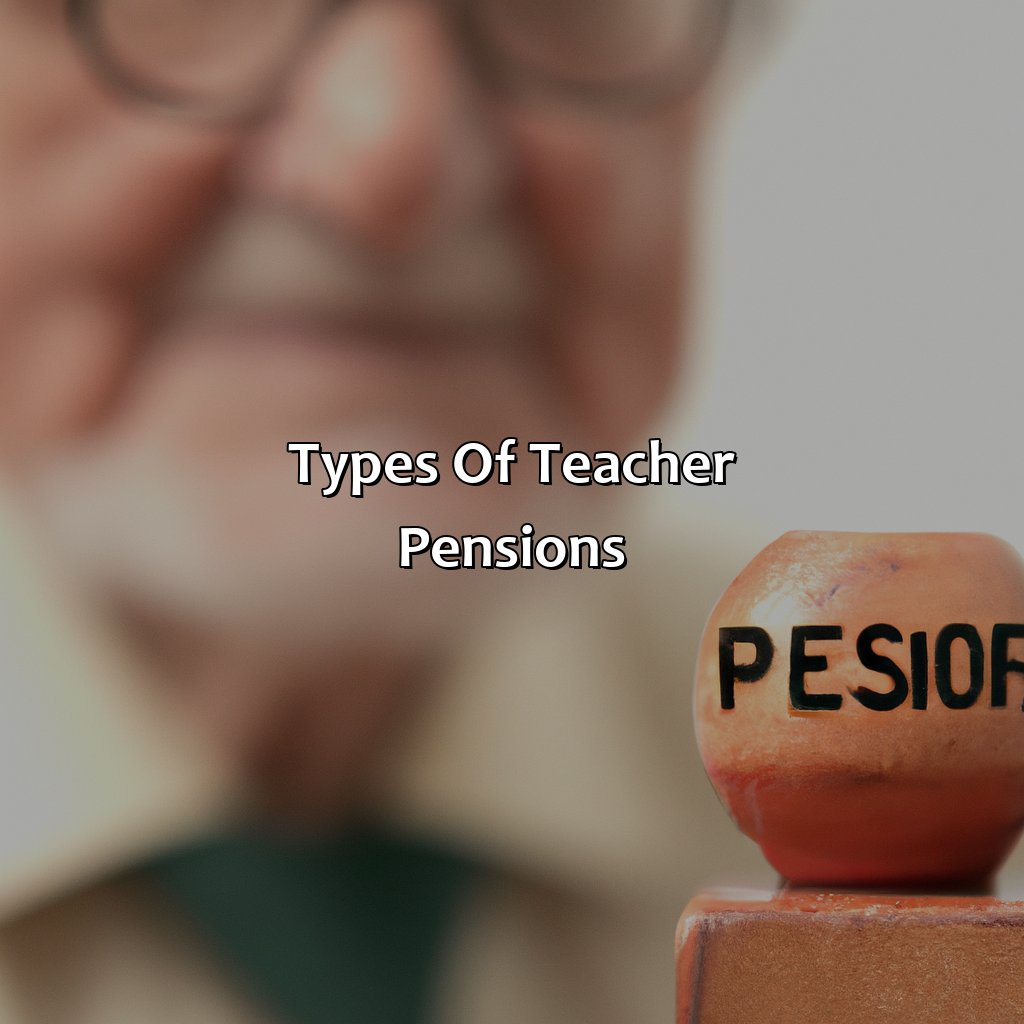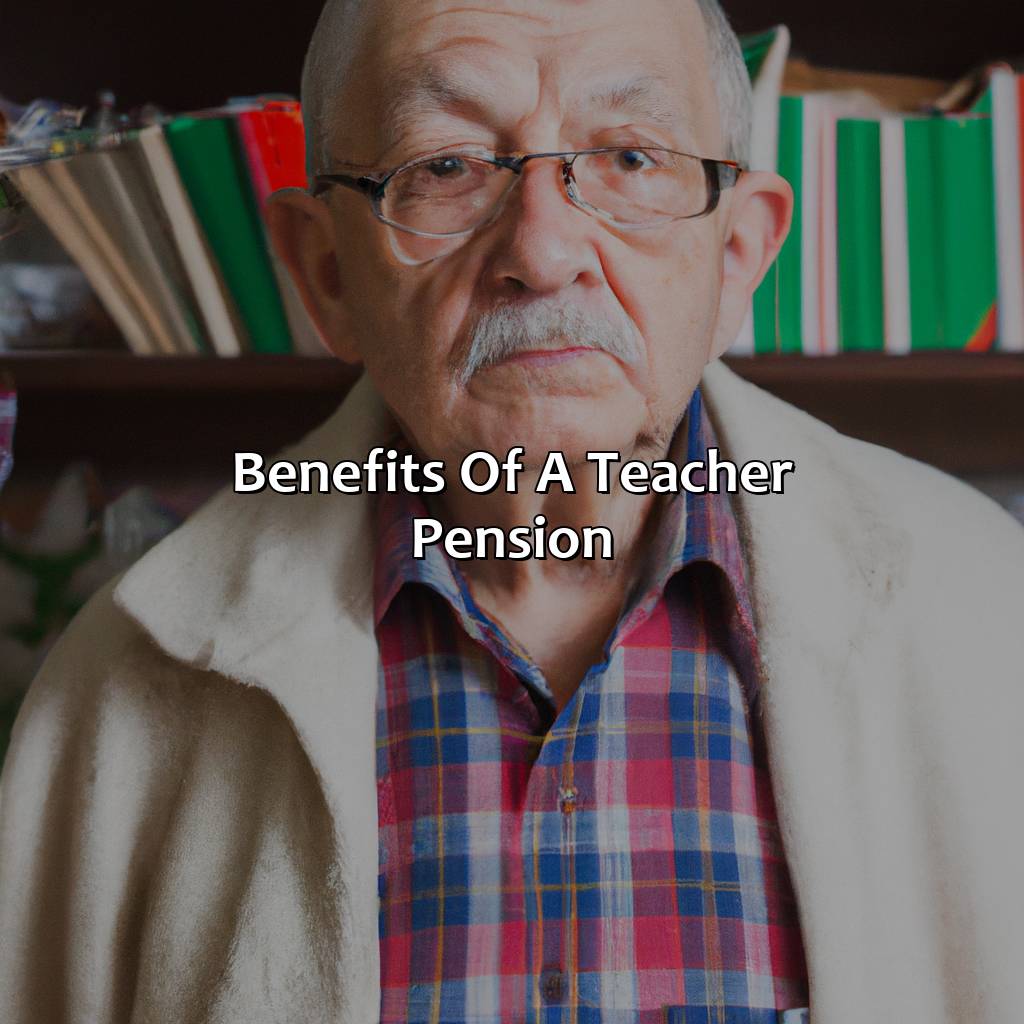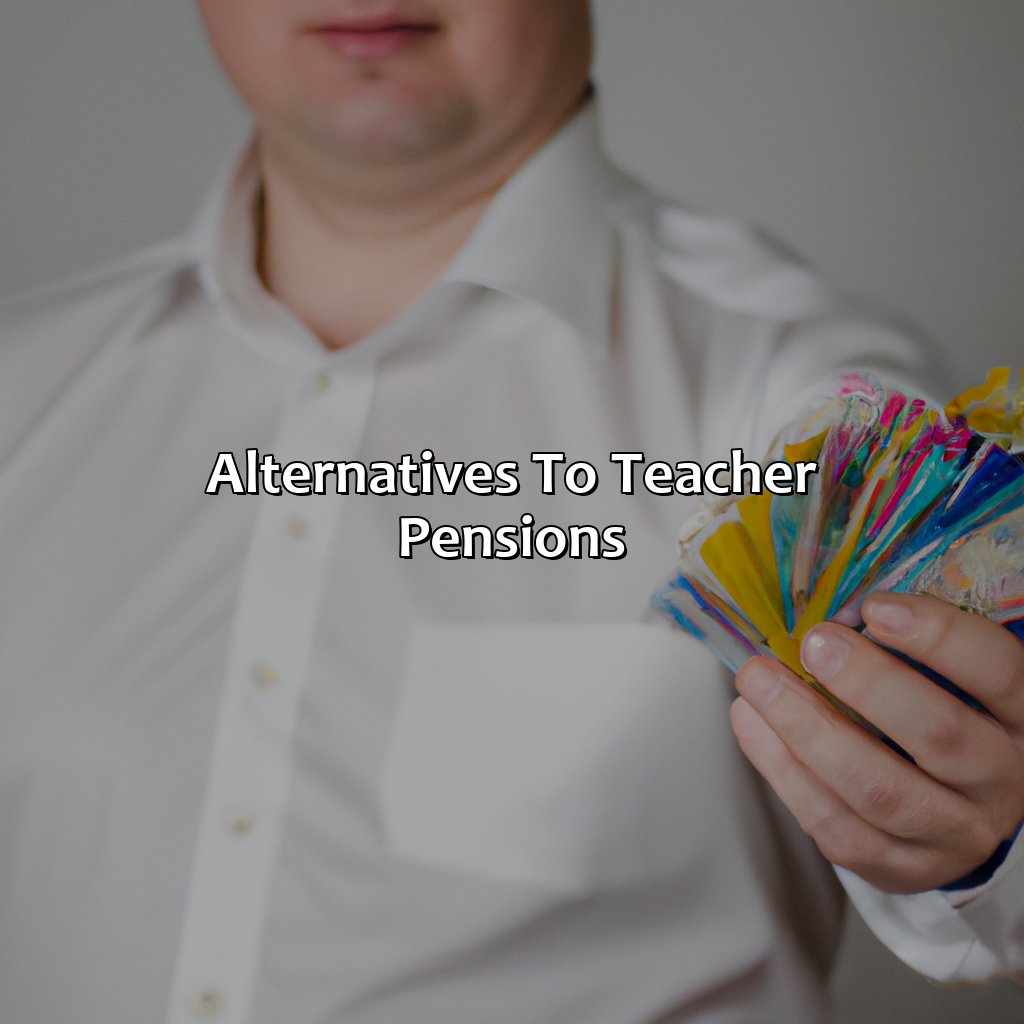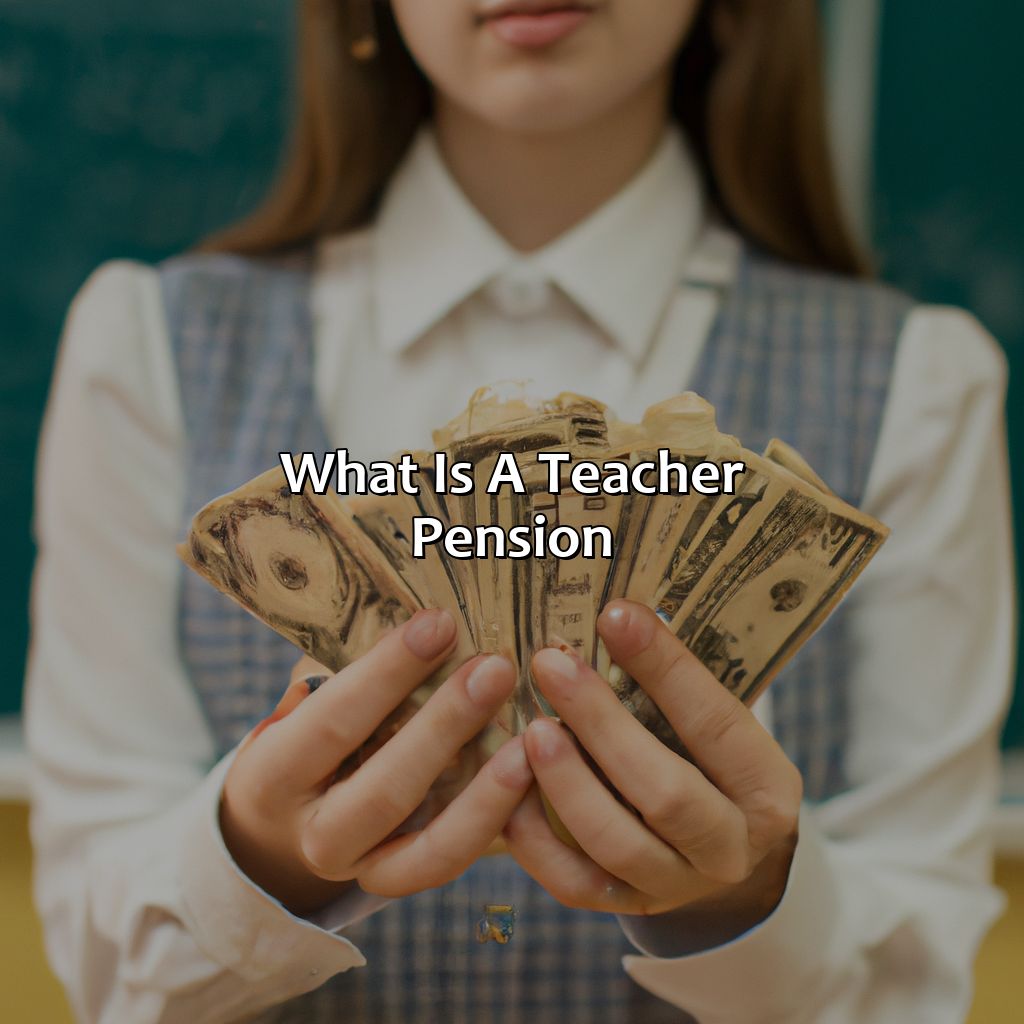What Is A Teacher Pension?
Key Takeaway:
- Teacher pension refers to a retirement plan specifically designed for educators, which guarantees them an income after retirement in exchange for their services during their active years.
- There are two types of teacher pensions: defined benefit pension plans, which provide a guaranteed income based on specific formulas, and defined contribution pension plans, which allocate a portion of contributions to individual accounts that grow with investment earnings.
- Benefits of a teacher pension include retirement security, stable income in retirement, and survivor benefits that offer financial protection to the spouse or dependents of a retired teacher in the event of their death.
Do you want to know what a teacher pension is and how it works? Read on to understand more about this important retirement benefit you’re entitled to as a teacher. With this comprehensive guide, you’ll be prepared for retirement with the right financial plan.
What is a teacher pension?
What is a teacher pension? Dig deeper to uncover the valuable rewards of such a retirement plan. Define it – understand what it covers. Then, discover how it functions – get an idea of how you can benefit from it.

Image credits: retiregenz.com by Yuval Washington
Definition of a teacher pension
A teacher pension is a retirement benefit for educators that provides financial security after their teaching career ends. It is a form of pension provided by the educational institution, which typically requires contributions from both the teacher and employer.
This pension plan accumulates contributions over the course of an educator’s career and can be paid out as a lump sum or in regular installments after retirement. The amount of the pension is based on factors such as length of service, salary history, and retirement age. Have you ever wondered what happens if you have no pension? Find out more.
It’s important to note that teacher pensions are not uniform across different schools or states. Each educational institution has its own rules and requirements for eligibility, contribution rates, and payout amounts.
To maximize the benefits of a teacher pension, it’s essential to understand your institution’s specific rules and regulations. Educators should also consider contributing more towards their pension plan to ensure sufficient financial support during their retirement years. By doing so, they can enjoy their golden years with peace of mind knowing they have a reliable source of income. You can learn more about what is the normal pension age for teachers at our website.
A teacher pension works like a magical savings account that only rewards you once you’ve dedicated your life to the noble profession of enduring endless kids’ shenanigans.
How a teacher pension works
A teacher pension is a retirement plan for educators that provides financial security after their employment ends. These pensions are typically funded by both the employers and the employees’ contributions throughout their careers. The amount of the pension payment is calculated based on factors such as years of service, retirement age, and salary at retirement.
In most cases, once an educator has retired, they will receive monthly payments from their pension fund until death. In some rare cases, if an educator passes away before retiring, their spouse or beneficiaries may be eligible to receive benefits. However, regulations and eligibility criteria for different plans may vary.
It’s important to note that teacher pensions can differ significantly between states and countries. Some governments offer more generous plans than others, while some have even decided to move towards a defined contribution plan instead of defined benefit plans.
Interestingly, the concept of teacher pensions dates back to ancient Rome where teachers were given lifetime stipends not only as compensation but also as recognition of their contributions to society.
Overall, while teacher pensions offer stable support for educators in their retirement, it’s important for individuals to understand how their specific plan works and whether additional retirement savings options may be necessary to ensure a comfortable future beyond work. If you are wondering what happens to your pension if you are terminated, it is best to consult with your plan administrator or financial advisor for specific information.
From gold-plated to barely-there, the types of teacher pensions are like a box of chocolates – you never know what you’re gonna get.
Types of teacher pensions
Plunge into the realm of defined benefit and defined contribution pension plans to understand the various teacher pensions. Defined benefit plans provide predictable retirement payouts, while defined contribution plans depend on elements such as investment performance and employee payments.

Image credits: retiregenz.com by Joel Jones
Defined benefit pension plans
A defined benefit pension plan is a type of retirement plan where an employer promises to provide a specified retirement benefit for its employees. This plan’s beneficence is calculated based on a formula using factors like age, years of service, and the employee’s salary.
While some pension plans allow employees to contribute, most of the funding comes from the employer. As they offer guaranteed benefits, these plans can be expensive and complex to administer.
One unique feature of defined benefit plans is that employers typically assume responsibility for investment risk. The plan may be insured by the Pension Benefit Guaranty Corporation (PBGC), which covers certain types of benefits if an employer cannot meet its obligations.
To ensure that retirees receive their promised benefits, it is essential to adequately fund the pension plan. Employers should regularly evaluate their funding levels and consider increasing contributions if necessary. They may also explore alternative investment options or actuarial assumptions to improve fund health.
“Teaching may be a tough gig, but at least with a defined contribution pension plan, you won’t have to resort to stealing pencils from your students to make ends meet in retirement.”
Note: The original text mistakenly mentions “defined contribution pension plan” in the last sentence instead of “defined benefit pension plan.”
Defined contribution pension plans
A defined contribution plan is a type of teacher pension where the amount contributed by both the employee and the employer is defined. This plan determines retirement benefits based on an individual’s account balance at retirement. Defined contribution plans are portable, which means that the employee can take their savings with them if they decide to leave the job.
These plans vary in terms of investment options, contribution limits, and vesting schedules. Some common types of defined contribution pension plans include 401(k) plans, 403(b) plans, and 457(b) plans. In a 401(k) plan, contributions are typically deducted from an employee’s paycheck before taxes are taken out, reducing their taxable income. Contributions to these plans may be matched by employers up to a certain percentage.
It is worth noting that unlike defined benefit pensions, which are typically managed by the employer, individuals must take greater responsibility for managing and investing their funds under defined contribution pension plans. Financial advisors recommend diversifying investments across multiple asset classes to reduce risk while also considering how much time remains until retirement.
In order to ensure a comfortable retirement, it is important for individuals to start saving as early as possible and aim to contribute amounts exceeding the minimum required contributions whenever possible. The more money saved at a younger age will result in more compounded interest over time. Additionally, increasing contributions as earnings grow or receiving matching contributions from employers can all significantly enhance long-term retirement security under a defined contribution pension plan.
Why sacrifice happiness now for a mediocre retirement, when you can have a teacher pension that ensures both?
Benefits of a teacher pension
Investigate the perks of a teacher pension! Retirement security, a reliable income in retirement, and survivor benefits are some of the advantages it can offer. Explore these benefits today!

Image credits: retiregenz.com by David Jones
Retirement security
As educators age, there is a natural question about how they will be taken care of in their golden years. An essential consideration for many teachers’ comfort during retirement is ‘Pension Benefits‘. Pension benefits can offer these working professionals invaluable peace of mind and lessen anxieties about financial security going forward.
With the advent of teacher pensions comes retirement security, offering countless benefits. Not only do these pension plans provide regular payments after a teacher’s retirement, but they also include investment strategies and options valuable to supplement any other sources of income. The steady cash flow offered through this secured plan remains an attractive option for eligible teachers.
Participating in these pension plans offers a lifetime stream of income to teachers post-retirement. These loans offer substantial allowances to members to enable them to enjoy maximum freedom once they leave the teaching profession entirely without worrying about economic stability. Have you ever wondered if you can get your parent’s pension when they die? Learn more about it.
Suppose you are looking for a wise investment strategy with appealing returns in your golden years; participating in your teacher’s pension plan should be at the top of your list! It is vital that interested individuals do their research on these programs before making an informed decision and consult knowledgeable professionals who can guide them according to individual circumstances.
If you are wondering how much of your teacher’s pension your husband will get when you die, it is important to check with your pension plan and read the terms and conditions carefully.
You might not be able to afford a yacht in retirement, but at least you won’t have to sell your kidney to pay the bills with a teacher pension.
Stable income in retirement
Retirement income security for educators is paramount. A pension plan guarantees income to retired teachers, providing consistent financial stability in retirement. This supported payout terms ensure a reliable and consistent flow of payments throughout the teacher’s retirement years.
Additionally, beyond the teacher’s working years, these benefits offer lifelong stability to address any challenges that may arise during retirement. A teacher can enjoy life without significant financial restrictions.
Many pensions also have provisions that enable spousal continuation – another perk of pension funds. Such provisions make sure that the spouse continues receiving payouts even after the educator passes away.
With rising living costs and ever-changing economic conditions, securing sufficient finances in retirement seems difficult. The scheme comes as a boon for educators providing them with peace of mind and several other perks like early buyouts or stronger benefits depending on tenure.
Overall, a stable and secure income through the use of teacher pensions ensures that former teachers enjoy a quality life while providing essential social services. Even in death, your loved ones can benefit from your career choice to be a teacher- because who doesn’t love a good survivor benefit?
Survivor benefits
Surviving relatives of retired teachers stand to gain certain benefits after a teacher’s death, making the profession an attractive career option.
- Financial support that is guaranteed for life for surviving spouses or dependents,
- The spouse might continue to receive pension payments even if they remarry.
- Eligible children receive survivor benefits until their adulthood, marriage, or successful adoption.
- The sum may include contributions from the teacher and the educational institution as well.
- In case of an active teacher’s death before retirement, their beneficiaries are eligible to receive survivor benefits based on their service length and the nature of their passing.
- If a retired teacher dies before having received all of their pension payments, the remaining amount will also be paid out to their surviving relatives.
Furthermore, it’s worth noting that these benefits vary widely between each state.
Pro Tip: Teachers can maximize their survivor benefit by contributing more towards retirement savings accounts and minimizing debts during employment. Enrolling in a teacher pension is like signing up for a lifelong subscription to worry-free retirement.
Eligibility and enrollment
Do you need to know how to qualify and enroll for a teacher pension? Here’s all the info you need! Qualifying factors are essential for eligibility. Plus, these steps will help you enroll. So, learn about the requirements that make you able to receive a pension. And read about the steps you need to take to enroll.

Image credits: retiregenz.com by Yuval Duncun
Qualifying factors for a teacher pension
In order to be eligible and enroll in a teacher pension scheme, certain criteria must be met. These requirements may entail years of service rendered, age or contributions made to the plan. Factors considered for teacher pensions may vary depending on the governing authority or agency responsible for the plan. It is therefore important for teachers to understand the specifics of their individual plans to ensure they meet all necessary requirements.
For instance, some pension plans may require a minimum number of years served as a teacher before one can qualify for benefits. Similarly, some plans may have age requirements where teachers can only start receiving benefits after attaining a certain age bracket. Moreover, contribution rates and amounts required by different agencies might also vary. If you want to know more about what happens to a teacher’s pension when they die, check out our article!
It is important to note that these qualifying factors may play out differently in each state or country’s pension system. Hence, it is essential to research specific state laws and policies relating to pensions.
It is reported that many teachers are not well-informed about their pension options and eligibility criteria; this jeopardizes their retirement planning. (Source: Center on Budget and Policy Priorities)
To learn more about what happens to your pension when you leave a job, it’s important to understand your options and eligibility criteria. This can help you make informed decisions about your retirement planning.
Enrolling for a teacher pension is like trying to sign up for a gym membership after Thanksgiving dinner- it’s a lot of paperwork and commitment, but worth it in the long run.
Enrollment process for a teacher pension
As a teacher looking to enrol in a pension scheme, there are certain eligibility requirements that you must meet. Once confirmed, the enrollment process depends on the specific pension fund you are joining. It usually involves completing paperwork and providing essential personal information such as your name, address and National Insurance number.
The information provided during the enrollment process determines how much contribution you make towards the pension scheme and your potential retirement benefits. After enrolling, you should receive regular statements outlining your contributions and projected pension payouts.
It’s worth noting that some pension schemes automatically enrol eligible teachers while others require manual application. It is advisable to seek guidance from your employer’s HR department or union representative on which option applies to you for a seamless enrollment experience. If you’re looking to opt out of teachers pension, RetireGenz can guide you through the process.
In today’s tumultuous economic times, failing to enrol in a teacher s pension can lead to uncertainties when it comes time for retirement. Don’t let fears of not meeting eligibility criteria hold you back; seek guidance from trusted sources and enroll as soon as possible to secure your financial future.
Teaching may be a thankless job, but at least you can retire with a pension to sustain you while your former students fund their therapists’ yachts.
Funding and sustainability of teacher pensions
To fund and sustain teacher pensions, you must investigate the sources of funding and challenges with sustainability. In this section, we will explore “Funding Sources for Teacher Pensions” and “Challenges to the Sustainability of Teacher Pensions.” Get ready to dive in!

Image credits: retiregenz.com by Joel Duncun
Funding sources for teacher pensions
One of the most crucial aspects of teacher pensions is funding sources. Without adequate funding, teacher pensions may face sustainability issues and fail to provide retirement benefits to teachers. Funders typically include the government, school districts, teachers, and sometimes private institutions.
- Government: Federal and state governments are major funders for teacher pensions. The government aids in providing financial assistance to teacher pension programs that can help ensure adequacy of funds.
- School Districts: School districts also contribute funds to support teacher pensions. Each district has its own policies regarding funding approaches which vary depending on their income or revenue streams.
- Teachers and Private Institutions: Both individual teachers and private organizations sometimes contribute directly to pension plans by paying into them on their own.
It’s worth noting that the source of funds allocated towards teacher pensions differ based on geographic location (city or state), economic status (low-income or high-income areas), level of education (primary or high school) among other factors. Hence, it’s essential that all involved parties continue to contribute finances to ensure fair and proper disbursement towards these schemes.
Investors like teachers who give stability to a community by living in one place for a long time would be at a disadvantage without proper pension funds. They’d have a sub-optimal old age because they were not able to avail lifestyle amenities before retiring due to economic pressures leading up until retirement age – leaving minimal opportunity for social activities. Thus individuals should encourage more people to pay attention towards teacher pension programs so that they may reap the incentives that will come with its successful implementation in the future.
Being a teacher means never having to worry about your pension, until politicians get involved.
Challenges to the sustainability of teacher pensions
Teacher pensions are facing various obstacles to their sustainability, such as the lack of adequate funding. This issue is largely attributed to the insufficient contributions by both teachers and their employers in pension plans. Moreover, the increasing life expectancy and retirement age of teachers have also put a strain on the sustainability of teacher pensions. Other challenges include governmental budget cuts, changing market conditions, and costly investment decisions.
In addition to these challenges, many states have taken on pension reform initiatives that often prove detrimental to teachers’ retirement benefits. Pension benefit reductions coupled with increased employee contributions may lead to a decrease in teacher retention rates, which could ultimately harm education quality levels. As a result, policymakers must balance short-term cost-cutting measures against long-term ramifications when considering the sustainability of teacher pensions.
Pro Tip: Utilizing diverse revenue streams outside traditional funding sources can offer new opportunities for enhancing teacher pension programs’ survival chances.
Why save for retirement when you can just become a professional couch surfer in your golden years?
Alternatives to teacher pensions
We got options for you! To help you make informed decisions about alternatives to teacher pensions, check out Social Security benefits and personal retirement savings plans. These could be great options that fit your money needs and goals.

Image credits: retiregenz.com by David Washington
Social Security benefits
Retirement benefits from the government are known as Income Security Programs. These are designed to provide a safety net for individuals who have retired and no longer receive income from work. Social Security benefits fall under this category, providing retirement, disability, and survivor’s benefits based on an individual’s work history. In addition to teacher pensions, Social Security can serve as another source of retirement income for educators. However, it may not be enough on its own and should be supplemented with additional retirement planning. One unique characteristic of Social Security is that it provides cost-of-living adjustments to help keep up with inflationary pressures.
According to the National Conference of State Legislatures, “In 2018-19, the average annual benefit received by retired teachers covered by state pension systems was $27,271.” This is slightly higher than the average Social Security retirement benefit of $18,036 in 2020. It should be noted that not all states require teachers to participate in Social Security and some may have alternate systems in place instead.
Say goodbye to living off ramen noodles in retirement and hello to actually enjoying your golden years with a personal retirement savings plan.
Personal retirement savings plans
Opting for an alternative personal retirement plan instead of a teacher pension can offer greater flexibility and control over retirement funds. These plans can include individual retirement accounts, Roth IRAs, 401(k) plans, or other employer-sponsored plans.
Individual retirement accounts (IRAs) provide tax-deferred growth on contributions and have various options such as traditional IRAs and Roth IRAs. 401(k) plans also offer tax benefits and can be offered by employers, including schools. Employer-sponsored plans offer possible matching contributions from the employer to increase savings.
Retirement savings plans that hold mutual funds or exchange-traded funds provide diversification in investment portfolios. High-yield savings accounts or money market accounts also provide safe options for retirement investments while earning interest.
Planning for retirement includes considering multiple factors such as anticipated living expenses, potential healthcare costs, and lifestyle choices. Retreating from traditional teacher pensions allows more control over personal financial goals while still achieving retirement security.
Five Facts About Teacher Pensions:
- ✅ Teacher pensions are retirement plans for educators in the public school system. (Source: NEA)
- ✅ They are funded through a combination of employee contributions and employer contributions. (Source: NCTQ)
- ✅ The amount of pension benefits a teacher receives is typically based on years of service and salary. (Source: Teachers’ Retirement System of the City of New York)
- ✅ Teacher pensions are often criticized for being underfunded and unsustainable in the long term. (Source: Pew Charitable Trusts)
- ✅ Some states have changed their teacher pension systems in recent years to address these concerns, such as by offering defined contribution plans or hybrid plans. (Source: Education Commission of the States)
FAQs about What Is A Teacher Pension?
1. What is a teacher pension?
A teacher pension is a retirement plan set up by an employer to provide retirement income for teachers. This plan allows teachers to save a certain amount of money each year and provides a guaranteed income stream upon retirement.
2. Who is eligible for a teacher pension?
Most public school teachers are eligible for a teacher pension plan. Eligibility requirements vary by state and may include age, years of service, and other factors.
3. How is a teacher pension funded?
Teacher pensions are typically funded through a combination of teacher and employer contributions and investment returns. The exact funding formula varies by plan and state.
4. How much will I get from my teacher pension?
The amount you will receive from your teacher pension will depend on your years of service, final average salary, and the specific plan your employer offers. You can typically calculate your estimated pension benefit using an online calculator provided by your pension system.
5. Can I receive my teacher pension in a lump sum?
While some pension plans allow for a lump sum option, most teacher pensions are paid out as monthly annuities. This provides a guaranteed income stream throughout retirement.
6. What happens to my teacher pension if I move to a different state?
If you move to a different state, you may be able to transfer your teacher pension to your new state’s pension system. If this isn’t an option, you may still be able to receive your pension benefits from your previous state’s pension system.
